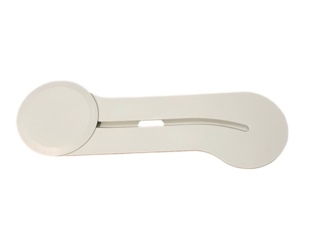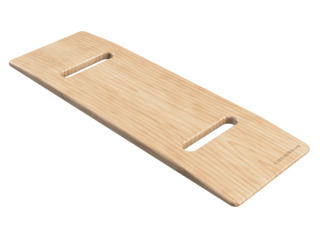¶ Introduction
A transfer board is any relatively thin, flat plank that is used to move from one seated position to another, such as from a wheelchair to a toilet.
Transfer boards vary in size and complexity; some are made of high-tech plastics, and have a moving disc to ease movement, while a piece of wood with sanded edges is also considered a transfer board.
¶ Start using when…
Standing to do a transfer is difficult or impossible; arm, shoulder, and trunk strength is sufficient to control the body while crossing the board
¶ Usage
An attendant is required to use a transfer board safely in the majority of cases.
The individual using the transfer board is likely not able to retrieve it from a storage location and place it under their own body independently.
Movement across the board should be supervised by someone standing nearby that is able to intervene in the case of a fall.
¶ Placing the board
The board must be placed under the individual before the other end can be placed at the destination. The individual must be able to use their arms to lift up or roll over adequately enough for an assistant to do the placement. Some surfaces, such as wheelchair seat cushions may be compliant enough that the transfer board can be stuffed under with minimal input from the individual using it.
Care must be taken when placing the board under the individual; there is a very high risk of striking the individual in their perineal area. It is critical that the board be placed under the individual's sit bones on both sides, or at least only on one side in such a way that the individual can then begin to transfer the second side on by themselves.
Placement of the board at the destination is straightforward, however, care must be taken to ensure that it is not too close to any of the edges at the destination, as it may shift during the transfer and fall off.
Downhill travel is ideal because gravity provides valuable support. Surfaces that can be adjusted in height, like hospital beds or electric wheelchairs with an elevation feature, can be positioned to ensure that trips to and from them are always downhill. While flat or moderately uphill journeys are possible for some people under certain conditions, they depend on individual strength.
¶ Moving across the board
The exact techniques used to make the journey across a transfer board can vary depending on the individual's strength, and what surfaces they are departing from and heading to. An assistant is required in most cases.
The assistant should spot the individual making the journey, and provide support to ensure that the transfer board does not move. The assistant should supervise the entire transfer until it is complete.
¶ Further Considerations
Transfer boards should not be used if the individual crossing it is not able to use their arms to maintain support of their upper body.
An assistant should always stand nearby and supervise the transfer. If the individual were to fall, the assistant should attempt to reduce the impact by helping to slow the fall. However, the assistant should not get entirely in the way of the individual falling, as they themselves may be injured.
Transfer boards should not be used at high elevations or on slippery surfaces.

